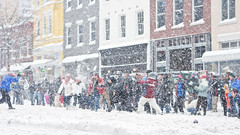|
Special Features





Image Libraries


|
|
Blog
Governor-elect McDonnell announced over the weekend that the next Virginia secretary of transportation will be Sean Connaughton.
Connaughton is a former chief of the U.S. Maritime Administration, and Chairman of the Board of Supervisors of Prince William County. While serving in the latter capacity he was a member of the Metropolitan Washington Transportation Planning Board.
What can we expect from him? Connaughton has been a centrist, extremely popular while in Prince William but not conservative enough to win a GOP party primary for major statewide office. He heartily supports the concept of Northern Virginia raising new sources of revenue specifically to be spent in Northern Virginia, and even as a Republican was a major advocate for the 2002 transportation tax hike referendum that eventually failed.
We can expect Connaughton to support more spending on transportation in general. He will likely continue road capacity expansion projects, probably including HOT lanes and the widening of I-66, but he will also likely support transit expansions. He is not considered to be hostile to transit in any way. No word so far on how he feels about bike/ped projects. Long story short, Connaughton may not be a dream candidate for urbanists, but he’s probably as favorable a choice as we could reasonably expect given a Republican governor. It seems unlikely he will be any worse – and he could be better – than outgoing secretary Pierce Homer.
One specific question that comes to mind: How will a hometown guy with a specialty in maritime transportation affect Prince William County’s proposal to run a ferry service up the Potomac? Seems plausible that project just got a whole lot more likely.
Average Rating: 5 out of 5 based on 280 user reviews.
December 23rd, 2009 | Permalink
Tags: government, people, transportation

Christmas is upon us. In a couple of days I’ll be flying to San Diego for a week. Until the new year posting to BeyondDC will be light, if at all. There could be posts if something interesting comes up and I’m in a position to write about it, but there will be no attempt to maintain anything resembling a regular schedule. Tweets will continue at more or less their usual rate.
Happy holidays.
Average Rating: 5 out of 5 based on 217 user reviews.
December 22nd, 2009 | Permalink
Tags: events, site

|
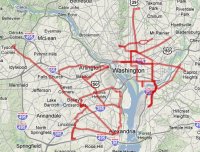
Consolidated inside-the-Beltway streetcar / BRT plan.
Click for Google Maps version. |
Plans for streetcars in DC and along Arlington’s Columbia Pike are well-known around the region, but they’re not the only exciting plans for new surface transit inside the Beltway. Arlington, Alexandria and Fairfax have quietly identified a number of corridors for significantly enhanced transit service.
Arlington:
The Transit Element of Arlington’s Master Transportation Plan identifies a “Primary Transit Network” of corridors in which the County wants to “encourage a low auto-usage lifestyle” by providing streetcar or BRT service with high frequency at all times of day. In addition to Columbia Pike, the PTN includes the Crystal City / Potomac Yard transitway, which Arlington wants to be a streetcar, as well as Lee Highway (US-29), Clarendon Boulevard, and Glebe Road. Presumably Arlington will focus on the latter three corridors once its plans for Columbia Pike and Crystal City are complete.
Alexandria:
The most prominent feature of Alexandria’s Transportation Master Plan is that the City identifies three “Priority Transit Corridors” on which they specifically propose to implement fully dedicated, no-cars-allowed, transitways. These transitways could be light rail or BRT, and are along US Route 1 (extending the CC/PY transitway), Duke Street, and Beauregard / Van Dorn.
Fairfax:
The recently released Fairfax County Transit Development Plan calls for three “streetcar or BRT” corridors: Columbia Pike, Route 7 and Route 28. Columbia Pike is simply the western segment of Arlington’s streetcar project. Route 7 is gaining momentum as a light rail corridor thanks to Congressman Moran. Route 28 (which is well outside the Beltway) appears to be a more distant goal.
Unfortunately, localities in Northern Virginia don’t control their transportation budgets to the same extent that DC (which is a state equivalent) does. While DDOT can fund and build streetcars directly, Northern Virginia localities currently lack the constitutional authority to adequately fund their own projects, and therefore have to work with Virginia’s state-level agencies to do so. This means Virginia won’t be able to move as fast as DC, and can’t be as up-front about determining streetcar versus BRT. Ultimately, these plans for Virginia are less secure than DC’s. Nonetheless, taken as a whole the plans that have come together for increased priority transit in Northern Virginia are extremely impressive, and would rival DC’s streetcar system if built.
Cross-posted at Greater Greater Washington.
Average Rating: 4.4 out of 5 based on 192 user reviews.
December 17th, 2009 | Permalink
Tags: featured post, transportation

DDOT’s three streetcars that were shipped from the Czech Republic last month have arrived. They were off-loaded at the Port of Baltimore over the weekend and taken by truck to WMATA’s Greenbelt railyards, where they will wait to be put into service. DDOT says it will take a few weeks to get the vehicles ready, but will make them available to be seen by the public soon.
This picture is one of a set of 14 on DDOT’s Facebook profile.
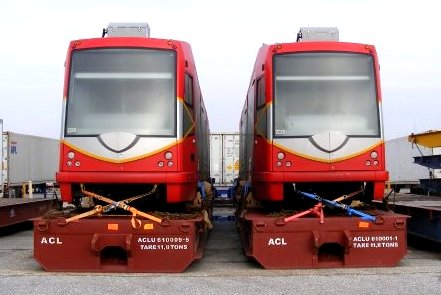
BeyondDC loves any opportunity to post about streetcars.
Average Rating: 4.6 out of 5 based on 269 user reviews.
December 15th, 2009 | Permalink
Tags: galleries, transportation

|

Why aren’t DC cabs this iconic?
Photo by flickr user Ian Muttoo. |
One of New York’s most iconic images is the yellow taxicab. The image you see at right is as instantly recognizable as the Statue of Liberty or Empire State Building. In London the black cab is just as iconic. In Berlin they are all white, in downtown Hong Kong they are red, and in Mexico City they are green and white. In all those cases, the taxicab livery is as much a symbol of the city as any building or institution.
But not in Washington. In Washington every taxi company has a unique paint scheme. We have Red Top and Blue Top and Yellow Cab (which is often orange) and a hundred other varieties. Are we missing an opportunity?
In most American cities there aren’t enough taxicabs for this to even be an issue. If you’ve got to call ahead to get a ride, taxis are not going to be part of your city’s brand recognition no matter what. But Washington, it turns out, has a ton of cabs. By some measures we have even more than New York (go to the 8th page of this report). When I step outside my Dupont-area home there are often more taxis on the street than private vehicles. Clearly DC *could* have an iconic taxi design if the city so choose.
Why don’t we? It seems like a great way to improve the city’s brand, while at the same time making taxis easier to identify and therefore hail. If any livery-defining regulation grandfathered existing cabs and simply resolved that new ones be uniform, operators wouldn’t have to sink money into repainting, and would likely save money on the painting of new vehicles thanks to economics of scale. Eventually turnover would result in a uniform fleet. Everybody wins.
What’s the down side? Why aren’t we doing this?
Average Rating: 4.6 out of 5 based on 157 user reviews.
December 14th, 2009 | Permalink
Tags: proposal, transportation

WTOP reports that yesterday the police wrote a $1, 000 ticket to an HOV violator on I-66 for his fourth such violation.
At what point does this person start to wonder if they’ve done something wrong?
Average Rating: 5 out of 5 based on 237 user reviews.
December 11th, 2009 | Permalink
Tags: law, transportation

Earlier this year the blog Conoperative put up a photo tour of what remains of Dupont Down Under, the trolley subway turned failed retail venture beneath Dupont Circle. One highlight is below; for the whole tour, go to Conoperative.
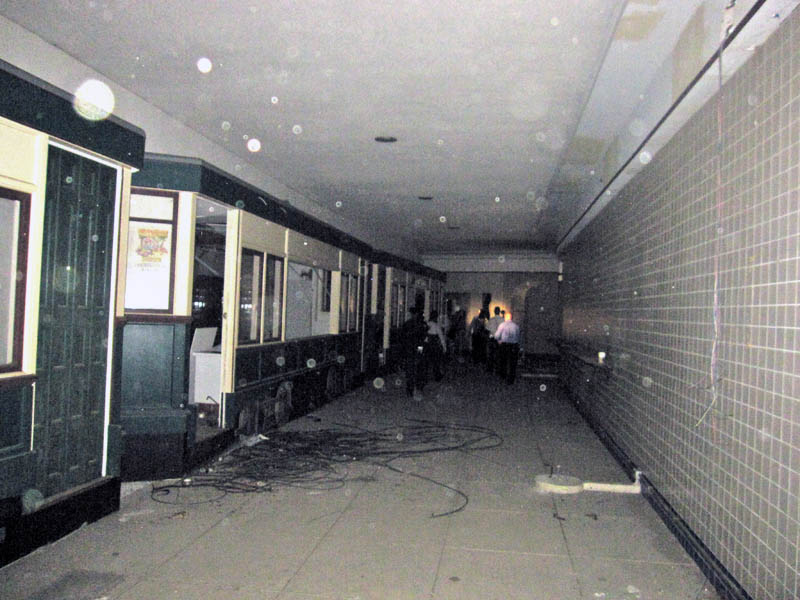
The trolley subway, with closed shops in the shape of trains on the left.
Update: Coincidentally, DC economic development officials said yesterday they are preparing an RFP for development of the tunnels. – 12/11/09
Average Rating: 4.7 out of 5 based on 243 user reviews.
December 10th, 2009 | Permalink
Tags: galleries

Greater Greater Washington today discusses bicycles on commuter rail, pointing out that MARC is one of only two commuter rail operators in the US not to allow non-folding bikes in their system. Near the end of the piece GGW mentions CalTrain’s bike cars as one progressive solution to the problem. Like airport buses outfitted to carry lots of luggage, the bike cars are outfitted to make bike storage easy.
I rode CalTrain earlier this year and took some pictures of the bike car on my train. Here they are:
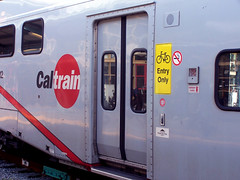 
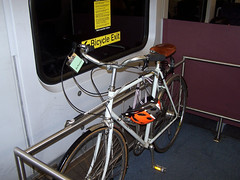
Average Rating: 4.7 out of 5 based on 288 user reviews.
December 9th, 2009 | Permalink
Tags: transportation

Yesterday DDOT added 8 new photos of the completed streetcar tracks at Benning Road and Oklahoma Avenue to its facebook gallery, including this one. Fun times.
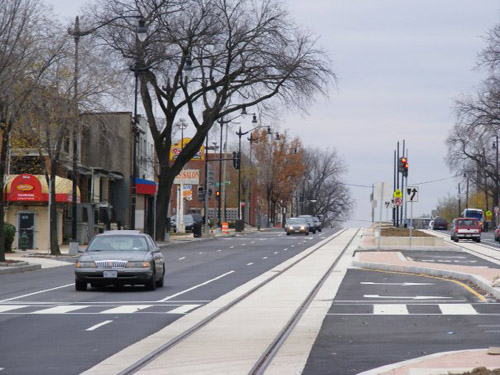
Average Rating: 5 out of 5 based on 268 user reviews.
December 8th, 2009 | Permalink
Tags: transportation

Here are the 10 most heavily ridden bus agencies in the region, ranked by ridership according to APTA’s latest report:
- WMATA – 442, 900 daily unlinked passenger trips
- Ride-On – 93, 700
- Fairfax Connector – 32, 000
- Dash – 13, 800
- The Bus – 13, 300
- Omni-Ride – 12, 400
- DC Circulator – 9, 000* (estimated; see note below)
- ART – 5, 100
- CUE – 3, 800
- Loudoun Transit – 3, 600
* APTA’s report doesn’t include information for the DC Circulator. The 9, 000 daily number is estimated from DDOT’s monthly report.
Bonus:
Ridership for the other large cities in Maryland and Virginia:
- Baltimore MTA – 279, 200
- Hampton Roads Transit – 49, 500
- Greater Richmond Transit – 33, 500
It’s quite shocking how much lower the Virginia cities are. Even though they’re smaller metro areas, I’d at least expect the regional transit agencies of Hampton Roads and Richmond to carry as many people as Montgomery County’s bus system. Actually, Ride-On is very impressive. If you browse through the APTA document above you can see that it carries more people than the regional bus agencies in several large cities.
Average Rating: 4.4 out of 5 based on 161 user reviews.
December 7th, 2009 | Permalink
Tags: top10, transportation

|
Media





Site
About BeyondDC
Archive 2003-06
Contact
Category Tags:
Partners
|










